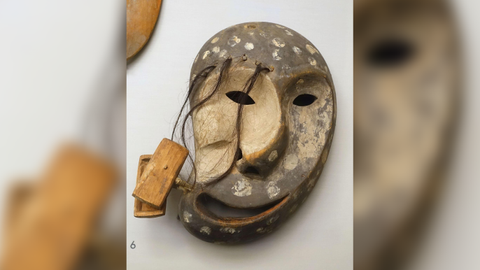Anthropology
Related: About this forumYup'ik masks: Carvings depicting distorted spirits' faces dreamed up by shamans in Alaska
By Kristina Killgrove
published 30 minutes ago
These masks, known for their distortion and asymmetry, are one of the oldest kinds of art in southwest Alaska.

Carved driftwood mask in the shape of a human face but distorted. There is hair coming out of the top of the right eye.
An example of a decorated Yup'ik mask carved from driftwood (Image credit: Alamy)
Name: Yup'ik spirit mask
What it is: A decorated mask carved from driftwood
Where it is from: Southwestern Alaska
When it was made: These masks date to at least the 16th century; the one photographed above dates to 1885.
What it tells us about the past:
The Yup'ik people, whose ancestors arrived in southwestern Alaska around 800 years ago, are known for their elaborate and often-fantastical-looking masks. But this artistic tradition was nearly eradicated in the late 1700s, as Russian missionaries likened the masks and their associated ceremonies to witchcraft.
Yup'ik masks vary dramatically in size and shape, anthropologist Dorothy Jean Ray wrote in her 1967 book "Eskimo Masks: Art and Ceremony," with some as small as 6 inches (15 centimeters) and others up to 4 feet (1.2 meters) long. These masks were traditionally carved from spruce driftwood found along the coast, with natural fibers added for movement — undulating feathers of the sea duck, rawhide or baleen for appendages, or human or caribou hair blowing in the wind. Color was added from natural pigments, such as white fingerprint dots created from white clay.
The first historic reference to Yup'ik masks was in a Russian traveler's diary written between 1764 and 1766, in which the man described the Yup'ik dancing in the nude while wearing masks.
Masks were an essential part of Yup'ik religious practice, according to Ray, and no two were alike. Typically, the Yup'ik shaman would commission a skilled carver to create a mask based on a dream or vision. Villagers then wore these masks during dances and festivals, such as whaling and caribou ceremonies connected to hunting practices.
More:
https://www.livescience.com/archaeology/yupik-masks-carvings-depicting-distorted-spirits-faces-dreamed-up-by-shamans-in-alaska
coprolite
(365 posts)A mask carved from the disk of a whale vertebrae, with sea lion and other mammal teeth. This was purchased by my father in the late 1950s.

Judi Lynn
(163,980 posts)It's a total work of art, to never be lost.
Thank you.